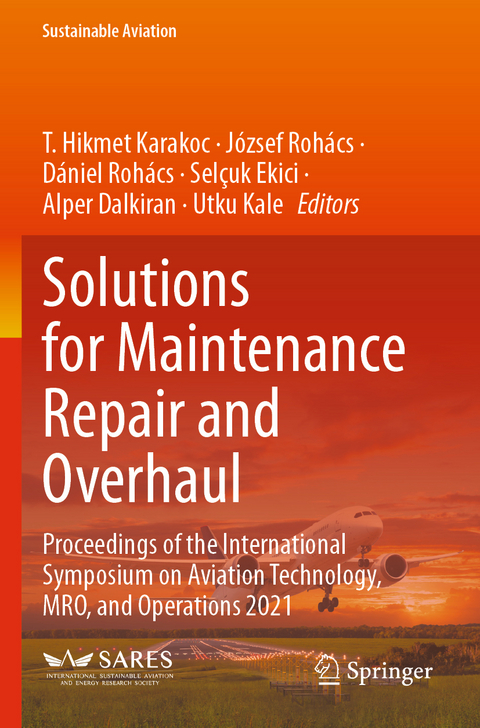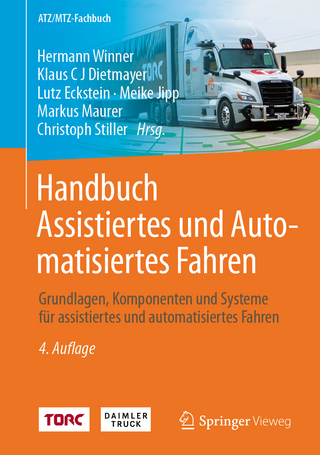
Solutions for Maintenance Repair and Overhaul
Springer International Publishing (Verlag)
978-3-031-38448-6 (ISBN)
- Noch nicht erschienen - erscheint am 01.12.2024
- Versandkostenfrei innerhalb Deutschlands
- Auch auf Rechnung
- Verfügbarkeit in der Filiale vor Ort prüfen
- Artikel merken
The International Symposium on Aircraft Technology, MRO, and Operations (ISATECH) is a multi-disciplinary symposium that presents research on current issues in the field of aerospace. The conference provides a platform offering insights on the latest trends in aircraft technology, maintenance, repair, overhaul, and operations that offer innovative solutions to the challenges facing the aviation industry. ISATECH allows researchers, scientists, engineers, practitioners, policymakers, and students to exchange information, present new technologies and developments, and discuss future direction, strategies and priorities.
T. Hikmet Karakoc, Ph.D., graduated from Anadolu University, the Department of Mechanical Engineering. He received his M.Sc. degree in Mechanical Engineering from the Yildiz Technical University. He received his Ph.D. from Anadolu University, where he started his full-time teaching and received his Full Professorship. He is currently researching at the Eskisehir Technical University. He has a wide range of research interests, including sustainable aviation, aircraft propulsion systems, insulation, heating, ventilating, and air conditioning (HVAC), indoor air quality, gas turbines, cogeneration systems, renewable energy, energy economics, fuels, and combustion. He has participated in numerous industrial projects on these topics as a researcher, consultant, and project manager for over 30 projects and corporations. He also started a contest on special insulation applications among university students. He served as an Editor-in-Chief, guest editor, and editorial boardmember for international scientific journals. He published national and international papers in over 300 journals and 40 books. Professor Karakoc actively follows membership positions for the Chamber of Mechanical Engineers and many sectorial associations, international scientific organizations, and societies. He is an active Board of Directors member of the International Association for Green Energy. He is currently holding the presidency of the SARES organization, which is actively supporting scientists and students in the area of sustainable aviation. He also organizes four symposiums on aviation subject areas as a Founding Chair.
Jozsef Rohacs, Ph.D., is a Full Professor emeritus at the Department of Aeronautics and Naval Architecture at the Budapest University of Technology and Economics (BME). He served 12 years as Dean for Scientific Affairs and led the Department of Aircraft and Ships for over 20 years. He has extensive experience in high-level advising at largecivil and military companies and managing small companies and foundations. Dr. Rohacs delivers lectures on numerical methods, numerical optimization, aerodynamics, flight mechanics, and control and development philosophies. He has an extensive practice in project management, including investigation, research technology, and product development. He was involved in many EU-supported projects (over 26 international projects), including EPATS, Sat-Rdmp, Sinbad, Pplane, Esposa, Innovate, SmartPolis, Nelui, and others, and coordinated the EU L1 level project, Gabriel. He is the professional and technical manager of the national project IDEA-e, developing the technology for electric and hybrid-electric propulsion systems and conceptual design for the 4-seater electric and hybrid cargo UAV aircraft.
Daniel Rohacs, Ph.D., is Head of the Department of Aeronautics and Naval Architecture at the Budapest University of Technology and Economics (BME). He served for the Research Development and Simulation Department at HungaroControl - Hungarian Air Navigation Services as the head of the department for many years. He worked for Eurocontrol (Bretagny) as a doctoral researcher for three years as a Ph.D. student at École Pratique des Hautes Études, Sorbonne (2004 - 2005), and visiting Ph.D. student at Princeton University. He has good management practice as a research director of SME Rea-Tech Ltd (since 2006) and CEO of RDS-X Ltd. (2005 - 2007). Dr. Rohacs is very active in international cooperation and research, including the EU-supported projects EPATS, Sat-Rdmp, Sinbad, Pplane, Esposa, Innovate, SmartPolis, and as project manager of L1 Gabriel project, USIS SESAR UTM, SafeFly, IDEA-e, and special projects at HungaroControl, including the introduction of free-routing and remote tower concepts into operation, developing new ideas, disruptive technologies, and solutions. He is active in international conference organizations and participates in IFAR (International Forumfo
Chapter 1. Cork Composites in Aerospace Applications .- Chapter 2. Low Velocity Impact Resistance of Nylon 6.6 Nanofiber Reinforced Epoxy Adhesives Used in Aircrafts.- Chapter 3. Determination of Optimum Mixing Parameter for Oil Flow Visualization.- Chapter 4. An Assessment of Digitalization in Aircraft Maintenance.- Chapter 5. Chip Breaking Applications and Chip Breaking Approach Using Variable Feed Rate in the Machining of Aviation Materials.- Chapter 6. SVD-Aided EKF for Nanosatellite Attitude Estimation based on Kinematic Relations.- Chapter 7. Developing New Concepts for the Integration of Drones into the General Air Transport Management and Urban Transport.- Chapter 8. Development of Aircraft Maintenance Procedures Using Lean Tools.- Chapter 9. Effect of Core Stitching on Flexural Properties of Lightweight Sandwich Composites.- Chapter 10. Environmental Impacts and Sustainability Practices of Airports.- Chapter 11. Evaluating Public Transport Development Projects by Multi-Criteria Methods.- Chapter 12. Human Error Assessment and Reduction Technique in Aircraft Maintenance .- Chapter 13. Assessment of Environmental Performance Indicators Based on Fuel Performance in an Aircraft Engine.- Chapter 14. Identification Performance Fields in Ground Handling Operations to Corporate Performance.- Chapter 15. Impact Performance of the Kaolin Filled Fiber Reinforced Polymer Facing Sandwich Structures.- Chapter 16. Analysis of the Airport Sustainability Plan in The Context of EONS Components .- Chapter 17. Optimizing Distributed Electric Aero-Propulsion Integration for a Novel Canard Aircraft Design.- Chapter 18. Effects of Cruise Flight Conditions on Power and Nox Emissions for High By-Pass Turbofan Engine.- Chapter 19. Conceptual Design and Sizing of Lidar Equipped Solar Powered HALE UAV for Coastal Surveillance in India.- Chapter 20. Investigation of Heat Loss by Radiation from External Walls of Airport Buildings Depending on Different Sky Cloudiness Factor.- Chapter 21. Optimal Layout Design of Multi-Rotor Vehicle Based on Pso Algorithm.- Chapter 22. Development of solar sail for interstellar exploration.- Chapter 23. Paperless Operations in Apron: A Case Study.- Chapter 24. Aircraft Inspection Using Drones - Benefits and Related Safety Concerns.- Chapter 25. Sizing and Performance Analysis of a Single-seat Tandem Helicopter.- Chapter 26. Optimization of the Surface of Drone Propeller Manufactured in 3d Printer .- Chapter 27. Preparation of Smart Gels with Stiffening Behavior.- Chapter 28. Noise and Vibration Measurement System.- Chapter 29. A New Encryption Key Generator Design with True Random Bits.- Chapter 30. A Case Study on Investigating Probabilistic Characteristics of Wind Speed Data for Green Airport.- Chapter 31. Enhancing Flight Safety Training and Prevention of Aviation Accidents with the Use of Physics and Aeronautics.- Chapter 32. Satellite Formation Flight Via NRM&EKF State Estimation Method.- Chapter 33. Evaluating the Effects of a Morphed Trailing Edge Flap for Aeroacoustics Applications.- Chapter 34. Modelling of Bird Strike for The Pilot Cabin Window in Side-By-Side Seated Aircraft.- Chapter 35. Impact Of Covid-19 On Air Traveler Behavior.- Chapter 36. The Feasibility of Hydrogen Fuel Cells as a Solution towards Zero-Emissions in General Aviation Aircraft.- Chapter 37. Conceptual Design of Piezoelectric Based Energy Harvesting Seats for Commercial Aircraft.- Chapter 38. Effects Of Flow Pulsation on Shock Wave/Boundary Layer Interaction in Supersonic Isolator.- Chapter 39. Effect Of Bypass Mass Injection on Thrust Vectoring of a Supersonic Micro Nozzle: A DSMC Investigation.- Chapter 40. Research on Starting Optimizing Control and Active Load Fluctuation Control of More Electric Auxiliary Power Unit.- Chapter 41. Computational Analysis of Re-Entry Space Vehicle at Supersonic and Hypersonic Speed.- Chapter 42. Sensor Fault Detection, Isolation and Accommodation Applied to B-747.- Chapter 43. Acoustic Emission andAcousto-Ultrasonic Monitoring in High Temperature Environments .- Chapter 44. Explicit Dynamic Finite Element Simulation of Plate Impacts for Damage Localisation .- Chapter 45. Macrocognition for Preparedness in Aviation.- Chapter 46. Simulation of A 6DOF Nonlinear Satellite Missile.- Chapter 47. Advanced Data Analytics and Digital Technologies for Smart and Sustainable Maintenance.- Chapter 48. Developing Models and Methods for Autonomous Drones in Urban Air Transport.- Chapter 49. Using a New Kerosen-Flame Bench Test to Analyse at Small Scales the Fire Reaction of Fiber Reinforced Polymer Matrix Composites.- Chapter 50. Impacts of Aircraft on Environment in Europe.- Chapter 51. Hybrid Nanoparticle Reinforced Polyurethane Composites Mechanical Behavior.- Chapter 52. Design of Experiments for Wind Tunnel Testing of 53° Sweep Lambda UCAV Configuration.- Chapter 53. Determination of Aerodynamic Characteristics for Leading-Edge Tubercle NACA 0015 Airfoil at Low Reynolds Number.- Chapter54. Comparison of GPS Based Position Estimation Methods.- Chapter 55. Investigation of the Accuracy of Terrestrial Radio Navigation Methods for Determining Aircraft Position.- Chapter 56. Development of an Efficient Finite Element Model for the Analysis of Buckling, Debonding and Collapse Characteristics of Composite Stiffened Panels under Compressive Loading.- Chapter 57. A Conceptual Inventory of Entropy Management About Exergetic Sustainability Based on Different Cruise Altitude for Aircraft Engines.
| Erscheinungsdatum | 12.11.2024 |
|---|---|
| Reihe/Serie | Sustainable Aviation |
| Zusatzinfo | XXII, 543 p. 273 illus., 233 illus. in color. |
| Verlagsort | Cham |
| Sprache | englisch |
| Maße | 155 x 235 mm |
| Themenwelt | Technik ► Fahrzeugbau / Schiffbau |
| Technik ► Luft- / Raumfahrttechnik | |
| Technik ► Maschinenbau | |
| Schlagworte | Aircraft composites • aircraft design • Aircraft Materials • Aircraft Structures • aircraft technology • Aviaition Maintenance Operations • Aviation, Environment and Sustainability • Fleet Planning • UAV |
| ISBN-10 | 3-031-38448-2 / 3031384482 |
| ISBN-13 | 978-3-031-38448-6 / 9783031384486 |
| Zustand | Neuware |
| Haben Sie eine Frage zum Produkt? |
aus dem Bereich


